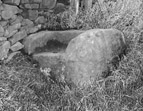Select a site alphabetically from the choices shown in the box below. Alternatively, browse sculptural examples using the Forward/Back buttons.
Chapters for this volume, along with copies of original in-text images, are available here.
Object type: Possible cross-base
Measurements: Unknown
Stone type: The pieces of broken stone at the site suggest the base was originally made from Millstone Grit.
Plate numbers in printed volume: Ill. 478
Corpus volume reference: Vol 13 p. 260-261
(There may be more views or larger images available for this item. Click on the thumbnail image to view.)
Two pieces of stone which are alleged to be part of an Anglo-Saxon cross-base, although now unrecognisable as such, are all that remain. These are badly worn and weathered and little remains to point to its original form, although Cox’s illustration (1907, 302) suggest it may have been square in section with a rectangular socket cut into it. One piece of stone has the initials P C cut into it (which was probably put there during a survey in the seventeenth century) along with a benchmark.
Appendix D item (plain cross-bases)
The site acquired its name from a non-conformist preacher who is said to have preached here in the eighteenth century. Other than the carved initials, the remaining pieces of stone could be taken for a fortuitous arrangement. However, when Cox visited the site around 1907, the base was partially intact but with one face broken away, so that it might have been perceived as a chair or throne. The remains of Anglo-Saxon cross fragments which were found nearby in 1987 (Pym Chair 1-2, p. 197) strongly suggest that a cross stood somewhere in the vicinity and that this may well have formed its base.



